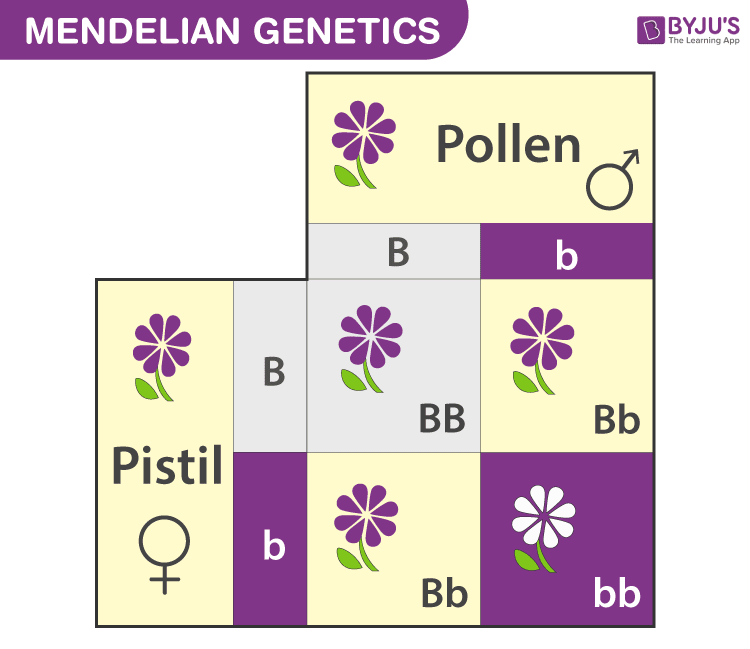
Mendelian Genetics is a kind of biological inheritance that highlights the laws proposed by Gregor Mendel in 1866 and rediscovered in 1900. These laws faced a few controversies initially but when Mendel’s theories got integrated with the chromosome theory of inheritance, they soon became the heart of classical genetics. Later, Ronald Fisher combined these ideas with the theory of natural selection and forms a base for population genetics and modern evolutionary synthesis.
Table of Contents
- Mendel’s Experiments
- Mendel’s Laws of Inheritance
- Law of Segregation
- Law of Independent Assortment
- Law of Dominance
Mendel’s Experiments
Gregor Mendel performed breeding experiments in his garden to analyse patterns of inheritance. He opted for cross-bred normal pea plants with selective traits over various generations. When two plants were crossed that differed in a single trait (round peas vs. wrinkled seeds, short stems vs. tall stems, white flowers vs. purple flowers, etc), Mendel found that the next generation, F1 comprised of whole individuals that exhibit only one trait. However, after the generation was interbred, its offspring which is the F2 generation showed a 3:1 ratio wherein three individuals had similar traits like a parent.
Mendel theorized that genes could be formed by three possible combinations of heredity units that are said to be factors: AA, aa, Aa. The big ‘A’ shows the dominant factor and the small ‘a’ shows the recessive factor. The beginning plants were homozygous AA or aa, F1 generation was Aa and F2 generation was AA, aa or Aa. The interaction between these two finds the physical trait that is visible.
According to Mendel’s law of Dominance, when two organisms of separate traits are crossed, every offspring shows the trait of only one dominant character. The recessive trait is expressed phenotypically only if both factors are recessive.
Also Read: Non-Mendelian Inheritance
Mendel’s Laws of Inheritance
Mendel’s conclusions could be described in the following principles:
Law of Segregation
According to the law of segregation, every parent’s pair of genes or alleles divide and a single gene passes from every parent to an offspring. Which particular gene passes on in a pair is entirely up to chance.
Law of Independent Assortment
According to the law of Independent Assortment, discrete pairs of alleles pass onto the offspring without depending on one another. Hence, the inheritance of genes at a particular region in a genome does not affect the inheritance of genes in a different region.
Law of Dominance
According to the law of dominance, recessive alleles are always masked by dominant alleles. Hence, a cross between a homozygous recessive and a homozygous dominant shows the dominant phenotype by still having a heterozygous genotype. This law could be explained by the monohybrid cross experiment. In the case of a cross among the two organisms with contrasting traits, the character that is visible in the F1 generation is known as dominant and the one that is suppressed is known as recessive. Every character is handled by a pair of dissimilar factors and only one among the characters shows the results. Please note that the law of dominance is true but not applicable from a global perspective.
Frequently Asked Questions – FAQs
What are the 3 principles of Mendelian genetics?
a) Law of Dominance
b) Law of Segregation
c) Law of Independent Assortment
Which allele is dominant and which one is recessive? And on what basis is it decided?
Why did Mendel choose garden peas for his experiments?
(i) The plant is neither too big nor too small, i.e. it can be easily handled.
(ii) It has many contrasting characters.
(iii) Pea flowers are cleistogamous (remain enclosed).
(iv) In pea flowers, self and cross-pollination both may be affected.
(v) A large number of offspring is produced after a single cross.
(vi) Cycle is short.
(vii) Flowers are bisexual and homogamous.
(viii) It has less number of chromosomes.
(ix) Garden pea plant does not show incomplete dominance.
(x) Experiments may be conducted in simple laboratory conditions.

Comments